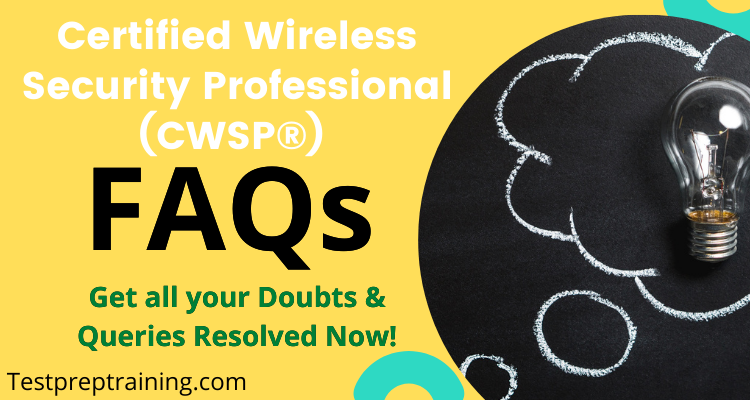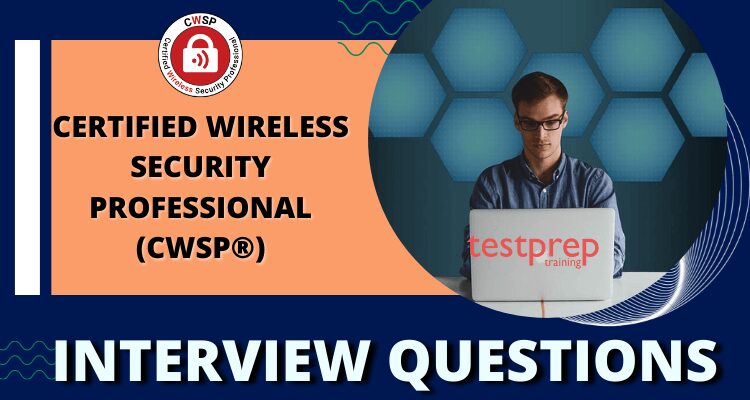Certified Wireless Security Professional (CWSP)

For the CWNP Program, the Certified Wireless Security Professional (CWSP) certification is a professional-level wireless LAN certification. The employee performs WLAN security audits and implements compliance monitoring systems, as well as gaining expertise in setting up Wireless Intrusion Prevention Systems (WISPS) and learning how to build a network’s security architecture.
Target Audience
- Network Admins or Consultants
- IT Professionals
The Certified Wireless Security Professional (CWSP) exam consists of 60 Multiple-choice Questions and is a professional level exam as the name suggests. The duration of the exam is 90 minutes and you must pass an online exam with a score of 70% or higher. The CWSP is a three-year certification, and it is renewed by passing the most recent version of the CWSP exam again. The cost of the exam is $275 USD
Eligibility Criterion
To earn a CWSP certification, you must hold a current and valid CWNA credential.
| Exam Name: | Certified Wireless Security Professional (CWSP) |
| Exam Number: | CWSP-206 |
| Number of Questions: | 60 |
| Exam Format: | Multiple-choice |
| Time Give: | 90 minutes |
| Available languages: | English |
| Exam Fee: | $275.00 (USD) |
| Validity | 3 years |
CWSP: Certified Wireless Security Professional Interview Questions
Scheduling The Exams
Now, let us understand the registration process for the exam
Registration Process
- To register for the exam visit your exam program’s homepage and log in if already register otherwise create a new account.
- Once, you have registered select the exam you’d like to schedule and fill in all the details.
- Click confirm to save all the changes and proceed to purchase the exam voucher and you have registered for the exam.
Exam Reschedule
- Visit your exam program’s homepage and sign in.
- Select the exam you’d like to reschedule or cancel from ‘Upcoming Appointments.’
- You will receive an email confirming any changes to your appointment.
- Don’t forget to click ‘Confirm Reschedule’ on the final screen to ensure your changes have been saved.
Test Taking
Pearson VUE
- Most CWNP exams (with the exception of CWS and CWT) are taken at Pearson VUE testing centers located worldwide.
- To schedule an exam or find a testing center near you, please visit the CWNP Pearson VUE website to create an account.
CWS and CWT
- Both CWS and CWT exams are hosted on our internal test-taking software.
- Exams are available to be taken anytime and must be taken in one single sitting.
- You will have all the information on how to log in to your account once you purchase a voucher.
Certified Wireless Security Professional (CWSP) FAQs
Get all your Doubts and Queries resolved with Certified Wireless Security Professional (CWSP) FAQs

Certified Wireless Security Professional (CWSP) Course Outline
The Certified Wireless Security Professional (CWSP) is as follows:
1.0 Security Policy – 10%
1.1 Define WLAN security Requirements
1.1.1 Evaluating and incorporating business, technical, and applicable regulatory policies (for example, PCI-DSS, HIPAA, GPDR, etc.)
1.1.2 Involve appropriate stakeholders
1.1.3 Review client devices and applications
1.1.4 Review WLAN infrastructure devices
1.2 Develop WLAN security policies
1.2.1 Translating security requirements to high-level policy statements
1.2.2 Write policies conforming to common practices including definitions of enforcementand constraint specification
1.2.3 Ensuring suitable approval and support for all policies
1.2.4 Implement security policy lifecycle management
1.3 Ensure proper training is administered for all stakeholders related to security policies and ongoing security awareness
2.0 Vulnerabilities, Threats, and Attacks – 30%
2.1 Identifying potential vulnerabilities and threats to determine the impact on the WLAN and supporting systems and verify, mitigate, and remediate them
2.1.1 Use information sources to identify the latest vulnerabilities related to a WLAN including online repositories containing CVEs
2.1.2 Deciding the risk and impact of identified vulnerabilities
2.1.3 Selecting appropriate actions to mitigate threats exposed by vulnerabilities
• Review and adjust device configurations to ensure conformance with security policy
• Implement appropriate code modifications, patches and upgrades
• Quarantine unrepaired/compromised systems
• Examine logs and network traffic where applicable
2.1.4 Describe and detect possible, common WLAN attacks including eavesdropping, man-inthe-middle, cracking, phishing, and social engineering attacks
2.1.5 Implementing penetration testing procedures to identify weaknesses in the WLAN
• Using suitable penetration testing processes including scope definition, information gathering, scanning, attack, and documentation procedures
• Selecting and using penetration testing tools including project documentation, scanners, hardware tools, Kali Linux, protocol analyzers, WLAN auditing tools (software and hardware)
2.1.6 Implementing network monitoring to identify attacks and potential vulnerabilities
• Using suitable tools for network monitoring including centralized monitoring, distributed monitoring, and Security Information Event Management (SIEM) systems
• Implementing mobile (temporary), integrated and overlay WIPS solutions to monitor security events
2.2 Describing and perform ingrisk analysis and risk mitigation procedures
2.2.1 Asset management
2.2.2 Risk Ratings
2.2.3 Loss expectancy calculations
2.2.4 Develop risk management plans for WLAN
3.0 WLAN Security Design and Architecture – 45%
3.1 Selecting suitable security solution for a given implementation and ensure it is installed and configured according to policy requirements
3.1.1 Selecting and implementing appropriate authentication solutions
• WPA/WPA2-Personal (Pre-Shared Key)
• WPA/WPA2-Enterprise
• WPA3-SAE and 192-Bit enterprise security
• 802.1X/EAP
• Understanding the capabilities of EAP methods including EAP-TLS, EAP-TTLS, PEAP, EAP-FAST, EAP-SIM, and EAP-GTC
• Guest access authentication
3.1.2 Selecting and implementing appropriate encryption solutions
• Encryption methods and concepts
• TKIP/RC4
• CCMP/AES
• SAE and 192-bit security
• OWE
• Virtual Private Network (VPN)
3.1.3 Selecting and implementing wireless monitoring solutions
• Wireless Intrusion Prevention System (WIPS) – overlay and integrated
• Laptop-based monitoring with protocol and spectrum analyzers
3.1.4 Understanding and explaining 802.11 Authentication and Key Management (AKM) components and processes
• Encryption keys and key hierarchies
• Handshakes and exchanges (4-way, SAE, OWE)
• Pre-shared keys
• Pre-RSNA security (WEP and 802.11 Shared Key authentication)
• TSN security
• RSN security
• WPA, WPA2, and WPA3
3.2 Implementing or recommend ingappropriate wired security configurations to support the WLAN
3.2.1 Physical port security in Ethernet switches
3.2.2 Network segmentation, VLANs, and layered security solutions
3.2.3 Tunneling protocols and connections
3.2.4 Access Control Lists (ACLs)
3.2.5 Firewalls
3.3 Implementing authentication and security services
3.3.1 Role-Based Access Control (RBAC)
3.3.2 Certificate Authorities (CAs)
3.3.3 AAA Servers
3.3.4 Client onboarding
3.3.5 Network Access Control (NAC)
3.3.6 BYOD and MDM
3.4 Implementing secure transitioning (roaming) solutions
3.4.1 802.11r Fast BSS Transition (FT)
3.4.2 Opportunistic Key Caching (OKC)
3.4.3 Pre-Shared Key (PSK) – standard and per-user
3.5 Securing public access and/or open networks
3.5.1 Guest access
3.5.2 Peer-to-peer connectivity
3.5.3 Captive portals
3.5.4 Hotspot 2.0/Passpoint
3.6 Implement preventative measures required for common vulnerabilities associated with wireless infrastructure devices and avoid weak security solutions
3.6.1 Weak/default passwords
3.6.2 Misconfiguration
3.6.3 Firmware/software updates
3.6.4 HTTP-based administration interface access
3.6.5 Telnet-based administration interface access
3.6.6 Older SNMP protocols such as SNMPv1 and SNMPv2
4.0 Security Lifecycle Management – 15%
4.1 Understanding and implementing management within the security lifecycle of identify, assess, protect, and monitor
4.1.1 Identifying technologies being introduced to the WLAN
4.1.2 Assessing security requirements for new technologies
4.1.3 Implementing suitable protective measures for new technologies and validate the security of the measures
4.1.4 Monitoring and auditing the new technologies for security compliance (Security Information Event Management (SIEM), portable audits, intrastructure-based audits, WIPS/WIDS)
4.2 Using effective change management procedures including documentation, approval, and notifications
4.3 Using information from monitoring solutions for load observation and forecasting of future requirements to comply with security policy
4.4 Implementing suitable maintenance procedures including license management, sofware/code upgrades, and configuration management
4.5 Implementing effective auditing procedures to perform audits, analyze results and generate reports
4.5.1 User interviews
4.5.2 Vulnerability scans
4.5.3 Reviewing access controls
4.5.4 Penetration testing
4.5.5 System log analysis
4.5.6 Report findings to management and support professionals as appropriate
Certified Wireless Security Professional (CWSP) Preparatory Guide

Now that we’ve learned more about the Certified Wireless Security Professional (CWSP) test and its requirements, it’s time to learn how to prepare for it. Exam preparation is a difficult endeavor that demands regular hard effort, attention, and perseverance. The Certified Wireless Security Professional (CWSP) exam is the first step toward a successful career in the IT industry. To pass this test, you must have a strong desire to study. However, there are several test materials accessible; you must select the one that is most suited to your needs. Our Preparatory Guide will assist you along your trip and will adequately prepare you for the test.
Step-1 Review the Exam Objectives
Reviewing the exam objectives is an important step to ensure that nothing is left out. As mentioned earlier, going through the course outline is really important while preparing for any exam to make sure everything is covered. Furthermore, Familiarizing yourself with the exam objectives helps is grasping concepts faster. The Certified Wireless Security Professional (CWSP) exam cover 4 topics namely-
- Security Policy
- Vulnerabilities, Threats, and Attacks
- WLAN Security Design and Architecture
- Security Lifecycle Management
Step-2 Discover your Learning Resources
Study Guide
The Certified Wireless Security Professional (CWSP)Study Guide will provide you complete clarity about the exam questions and how to approach them while preparing you from the scratch.
Reference Book
When it comes to studying, books are your best friends since they present you with unique insights that study guides may not, giving you an advantage over others. You are free to select any book that best matches your method of preparation. Check to see whether the text is clear and if the book includes a lot of practice problems and past exam papers. You may select from a variety of books and purchase them or consult libraries, but always search for books published by reliable and legitimate domain specialists. You can refer to the following books
Classroom Training
Instructor-led classroom training is the most effective approach to prepare for any IT test, including CWNP examinations and is provided by CWSP to its applicants. In their classes, authorized CWNP Learning Centers only utilize CWNT certified teachers and the approved CWNP courseware.
Online LIVE Training
Online Live training programs, which require both students and instructors to be online at the same time, are also available through CWSP. Meetings and lectures both take place at the same time. Students can meet their lecturer live via the internet during such live sessions to discuss various subjects or difficulties. In summary, you receive everything you get from in-person instruction without having to be there, and it’s a really effective and productive method to learn in the digital era.
E-learning
The eLearning Bundle for the Certified Wireless Security Professional (CWSP) test offers unrestricted access to the e-learning curriculum. This package would include animated movies that explain key terminology and topics, chapter questions to reinforce learning, interactive components to aid knowledge retention, and much more.
Step-3 Join Online Communities
Joining an online community, such as the CWNP Discussion Forums, is a great method to figure out where you are in the competition. You may communicate with your competition while staying focused here. Thousands of postings, questions, answers, and comments about real-world Wi-Fi settings are available to read. Additionally, having several points of view makes the content more dynamic and allows you to broaden your domain. Furthermore, these organizations will assist you in staying current with the exam while also boosting your confidence.
Step-4 Practice tests
Once you are done with your preparation phase, your performance phase begins. This phase is also referred to as the self-evaluation phase as it helps you find out your core strengths and weak spots. They also help you build confidence and learn time management. Moreover, Practice tests are designed in such a manner that it helps the candidates to encounter the real exam environment around them. Take the Certified Wireless Security Professional (CWSP) Free Practice Test Now!


